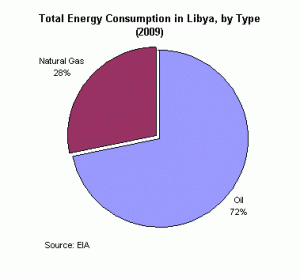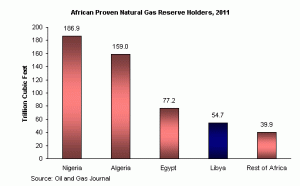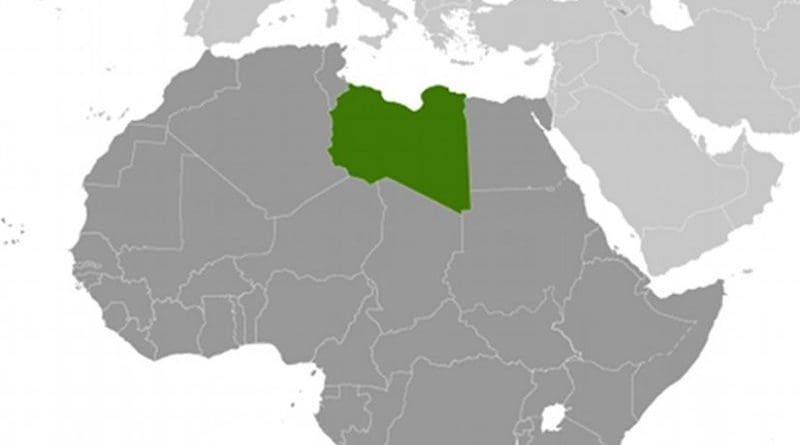Libya Energy Profile: Largest African Oil Reserves, But Still Underexplored
By EIA
The Libyan economy is heavily dependent on the hydrocarbon industry which, according to the International Monetary Fund (IMF), accounted for over 95 percent of export earnings in 2010. According to the Oil and Gas Journal (OGJ), Libya holds around 46.4 billion barrels of oil reserves, the largest in Africa, and close to 55 trillion cubic feet (Tcf) of natural gas reserves. In 2010, total oil production (crude plus liquids) was close to 1.8 million barrels per day (bbl/d).
The Libyan government plans to increase its oil reserves, production capacity, and further develop the natural gas sector in the medium-term as the country continues to recover from over a decade of U.S. and international sanctions.
The United Nations and the United States lifted sanctions on Libya in 2003 and 2004, respectively.
In 2006, the United States rescinded Libya’s designation as a state sponsor of terrorism. Since then, international oil companies have stepped up investments in hydrocarbon exploration and production despite some degree of regulatory and contractual uncertainty.
Libya’s energy consumption mix has remained relatively constant throughout the last decade, with approximately 72 percent of energy demand being met by oil and 28 percent by natural gas.

However, with electricity demand on the rise, the government is planning to expand the use of natural gas to meet domestic electricity generation needs while also exploiting solar and wind potential in more rural areas.
Natural gas currently represents about 40 percent of generated electricity.
Oil
Libya has the largest proven oil reserves in Africa but most analysts agree that the country is still underexplored.
Libya, a member of the Organization of Petroleum Exporting Countries (OPEC), holds the largest proven oil reserves in Africa, followed by Nigeria and Algeria (see below).
According to Oil and Gas Journal (OGJ), Libya had total proven oil reserves of 46.4 billion barrels as of January 2011, the largest reserves in Africa.
Close to 80 percent of Libya’s proven oil reserves are located in the Sirte basin, which accounts for most of the country’s oil output.
Libya hopes to increase oil reserve estimates with incentives for additional exploration both in established oil producing areas as well as more remote parts of the country.

Recent increases in foreign investment have begun to slow as a result of uncertainties stemming from OPEC quotas, infrastructure constraints, and contract renegotiations.
Production
Despite Libya’s oil reserves, oil production peaked at over 3 million bbl/d in the late 1960s and has since been in decline.
The National Oil Company (NOC) would like to return oil production capacity back to 3 million bbl/d – a target that the NOC has delayed until 2017.
Nonetheless, crude oil capacity has increased somewhat over the past decade from 1.43 million bbl/d in 2000 to 1.8 million bbl/d in 2010.
Crude oil production in 2010 was approximately 1.65 million bb/d, about 150,000 bbl/d below capacity but still above the production quota set by OPEC, currently at 1.47 million bbl/d.

Most of the short-term oil production increases are expected to come from enhanced oil recovery (EOR) processes and any major new production in Libya will require additional pipeline capacity for exports.
According to Wood Mackenzie, about two-thirds of Libyan oil production comes from the Sirte Basin, with about 25 percent also coming from the Murzuq basin and most of the remainder coming from the offshore Pelagian Shelf Basin near Tripoli.
Exports
With domestic consumption estimated around 270,000 bbl/d in 2010, Libya’s net exports (including all liquids) were slightly over 1.5 million bbl/d.
According to the International Energy Agency (IEA) the vast majority (around 85 percent) of Libyan oil exports are sold to European countries namely Italy, Germany, France, and Spain.
With the lifting of sanctions against Libya in 2004, the United States has increased its imports of Libyan oil.

According to EIA January through November estimates, the United States imported an average of 71,000bbl/d from Libya in 2010 (of which, 44,000 bbl/d was crude), up from 56,000 bbl/d in 2005 but a decline from 2007 highs of 117,000 bbl/d.
Libyan oil is generally light (high API gravity) and sweet (low sulfur content). The country’s nine export grades have API gravities that range from 26.0o – 43.3o. While the lighter, sweeter grades are generally sold to Europe, the heavier crude oils are often exported to Asian markets.
Refining
According to OGJ, Libya has five domestic refineries, with a combined capacity of 378,000 bbl/d. Libya’s refineries include:
1) the Ras Lanuf export refinery, completed in 1984 and located on the Gulf of Sirte, with a crude oil refining capacity of 220,000 bbl/d;
2) the Az Zawiya refinery, completed in 1974 and located in northwestern Libya, with crude processing capacity of 120,000 bbl/d;
3) the Tobruk refinery, with crude capacity of 20,000 bbl/d;
4) Sarir, a topping facility with 10,000 bbl/d of capacity; and
5) Brega, the oldest refinery in Libya, located near Tobruk with crude capacity of 8,000 bbl/d.
Libya’s refining sector was impacted by UN sanctions, specifically UN Resolution 883 of November 11, 1993, which banned Libya from importing refinery equipment. Libya is seeking a comprehensive upgrade to its entire refining system, with a particular aim of increasing output of gasoline and other light products.
Sector Organization
Libya’s oil industry is run by the state-owned National Oil Corporation (NOC). The NOC is responsible for implementing the Exploration and Production Sharing Agreements (EPSA) with international oil companies (IOCs). NOC is also responsible for field development and improvements as well as downstream activities. IOCs operating in Libya work in exploration, production, transportation and refining.
IOCs with operations in Libya include Eni, Total, Repsol YPF, StatoilHydro, Occidental, OMV, ConocoPhillips, Hess, Marathon, Shell, BP, ExxonMobil and others.
IOC participation in Libya’s oil concessions was initially as high as 49 percent. However, changes to the production sharing agreements under the EPSA – IV licensing round (2005) limited IOC production shares. The Libyan government has since required that IOCs already operating in the country rewrite existing contracts to comply with the new framework. The key elements include a reduction of the companies’ share of output (up to half of what it was), a commitment of fresh investment in exchange for an extension of the license period (some up to 15 years).
Overseas Investment
In 2009, the Libyan government invested in Eni, an Italian oil company that has been operating in Libya since 1959 and is Libya’s largest foreign oil producer. Through the country’s sovereign wealth funds, Libya has been eyeing additional energy investments in Europe and Africa.
Libya also has refinery operations in Europe through its overseas oil retail arm, Tamoil. Through Tamoil, Libya is a direct producer and distributor of refined products in Italy, Germany, Switzerland, and Egypt.
Natural Gas
Libyan natural gas production and exports have increased considerably since the opening of the “Greenstream” pipeline to Europe in late 2004.
Libya’s proven natural gas reserves as of January 1, 2011 were estimated at 54.7 trillion cubic feet (Tcf) according to the Oil and Gas Journal. Recent new discoveries and investments in natural gas exploration are expected to raise these estimates in the near-term.

The Libyan government plans to significantly increase the country’s natural gas production in order to expand the use of natural gas in the power sector in order to free up more oil for export while maintaining and expanding existing pipeline and LNG exports.
These objectives will be met by further promoting the development of existing and new discoveries, while at the same time reducing the volumes of flared natural gas (estimated at 125 Bcf in 2009).
Production
Libya’s natural gas production has grown substantially in the last few years. According to EIA, Libya produced 1,034 billion cubic feet (Bcf) of gross natural gas in 2009 of which 562 Bcf was marketed dry natural gas – the remainder was vented, flared or re-injected to enhance oil recovery.
Natural gas currently accounts for 45 percent of generated electricity. Despite plans to increase natural gas use for electricity generation, project delays and infrastructure limitations have kept consumption in this sector relatively stable over the past decade.

However, the International Energy Agency (IEA) is estimating that by 2012, domestic consumption could increase by as much as 50 percent if planned pipelines and gas-fired power plants come online.
Consumption and Exports
In 2009, Libya consumed 212 Bcf and exported 349 Bcf of natural gas to Europe. The vast majority of this was exported by pipeline, with a small volume exported in the form of liquefied natural gas (LNG). Natural gas is piped from the Wafa concession and the offshore Bahr es Salam fields to Melitah, where it is treated for export.
Natural gas exports to Europe have grown considerably over the past several years through the 370-mile “Greenstream” underwater natural gas pipeline from Melitah to Gela in Sicily. From Sicily, the natural gas flows to the Italian mainland. The Greenstream pipeline came online in October 2004 and is operated by Eni in partnership with NOC.
Liquefied Natural Gas (LNG)
In 1971, Libya became the second country in the world (after Algeria in 1964) to export LNG. Since then, Libya’s LNG exports have remained low, largely due to technical limitations.
Libya’s LNG plant, at Marsa El Brega, was built in the late 1960s by Esso and has a nameplate capacity of about 125 Bcf per year. However, U.S. sanctions prevented Libya from obtaining necessary technology to separate out LPG from the natural gas, thereby limiting the plant’s output by over half of capacity. In 2009, LNG exports increased slightly to 24.4 Bcf, all of which was exported to Spain.
Sector Organization
Libya’s natural gas industry is mostly state-run, although a number of international firms participate in the sector. International companies participate in exploration, production, and transportation of natural gas. International companies with operations in Libya include Eni, BP, Shell, ExxonMobil and others.
Source: EIA

